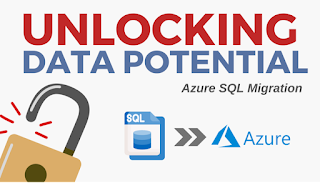Unlocking Data Potential: Azure SQL Migration
Today, in our data-driven world – where data is seen as the currency and asset, companies are on the run to make the most out of the data they have. And it’s a fascinating phenomenon – data becoming increasingly integrated into our lives.
To open up the doors of greater possibilities, companies must ensure that their data are safe, stable, and efficient. That’s why migrating to cloud-based services such as Azure has become commonplace.
Migrating your SQL Server databases to Azure gives that much-needed turbo boost for enterprises to up their data game. It helps them scale up, break innovative practices, and beef up how secure their data could be. Add to that, cost-efficiency to make sure the investments go into the right place.
With Azure, ever-growing cutting-edge technology, consistent updates, and top-notch support comprise the full package. You can think of it as putting your data on steroids! This article will break down why you should, and just how you could do that migration.
Why Migrate to Azure?
Azure is a powerful data solution, indeed. But why are companies choosing to migrate their SQL server databases to this dynamic platform? There are many reasons. Stable and secure storage of data, flexibility and scalability, helpful analytics, and seamless integration are just some. Let’s delve deeper into the reasons and explore how they might be yours too.

Enhanced Security and Compliance:
Azure’s commitment to data security is something we should take notice of. With its top-notch security features and robust infrastructure, you can rest easy knowing your precious data is safe and sound. Azure offers great features such as multi-factor authentication, threat detection, and encryption to provide the necessary layers of security.
95% of Fortune 500 companies are known to trust Azure with their data and digital transformation efforts. It also adheres to US and European security frameworks making it a solid choice, especially for companies that deal with sensitive data. With all the features put in, you can be sure your data is guarded 24/7/
Scalability and Flexibility:
Azure gets you what you need when you need it. The platform allows you to scale your resources – increase or decrease storage – in just minutes, and pay only for exactly what you use.
It’s perfect for live websites that handle heavy amounts of data while gaining subscribers by the hour. Scalability also means stability. That simply means fewer data crashes and overloads.
You can save tons from your budget with Azure making it one of the most cost-effective solutions out there. In fact, a Forrester report says that companies have saved up 30% of their data storage costs by migrating to Azure.
Advanced Analytics and AI:
Azure offers nifty tricks and tools for data enthusiasts. You could maximize services such as Azure Machine Learning and Azure Synapse Analytics to take a deeper look and gain insights from your data.
Take, for example, companies that produce smart cars and other similar products, which can make use of Azure’s AI capabilities to help their operations and ensure more intelligent learning. This can be applied to different smart features such as car security systems, computer-aided navigation, and the like.
Azure helps you turn the raw data into actionable intelligence. With its high-speed learning and processing, you can sift through the sea of data and harness the most useful nuggets to be found.
Hybrid Capability:
Azure helps you get the best of both worlds. It’s built to seamlessly integrate your on-premises data centers with the Cloud. Once you master how to use it, you’ll have something akin to a bullet train from the Cloud in the sky right to your office doorstep.
Integrating and streamlining your data sources will help ensure better and smoother data migration and business continuity.
The SQL Migration Process
Data migration is not an easy task. But with careful planning and a spot-on to-do list, you can breeze through it like a well-choreographed dance. Each step is important. You begin by assessing the current situation, doing the necessary preps, checking if it works well, and then, ensuring your team gets the hang of the new setup. Let’s break it down into four essential stages:

1. Assessment and Planning: Before we sail, let’s chart the course first. Organizations that plan on migrating their data must first assess their existing infrastructure, identify the dependencies and come up with a meticulous plan for the migration strategy. This step is paramount to avoid potential disruptions. Studies have found that a sizeable number of migration projects are more costly because of poor planning.
2. Migration and Testing: With the roadmap in hand, we put the data onboard and start sailing. The actual migration takes place in this step. Afterwards, it should be paired with comprehensive testing. We want to ensure the data integrity and security within the new Azure environment. More often than not, there are issues that arise with a newly migrated system, so it’s best to look for them early on to avoid the messier complications down the line.
3. Optimization and Monitoring: Of course, migration cannot be done in just a one-time engagement. Continuously, organizations must conduct optimization and monitoring. This is needed to maintain peak performance, security, and resource efficiency while using Azure. Keeping your system optimized and secure can cut down your operational costs and protect your data from security risks and threats.
4. Training and Adoption: Your team must now steer the wheel. In this crucial last step, you need to equip your workforce with the skills required to efficiently operate Azure SQL. Adoption means the team is comfortable and knowledgeable enough about the system to enable them to work independently. When this is successful, productivity can be increased further with an empowered and confident team.
Best Practices for SQL Migration
Comprehensive Assessment: It’s always best to look into everything before moving forward and taking the plunge. Set up a meeting with all the stakeholders, not just IT. Throw in all the necessary info, including your business goals and risks then take some suggestions. Tools like Azure Migrate can give you insights on how to best carry out the process.
Incremental Migration: Do it little by little. And don’t bite off more than you can chew. Prioritize your data and applications based on criticality. Take the essentials first, then follow through with the rest. When they’re in place, you’d get the general feel of the system so you can begin with performance monitoring.
Performance Tuning: Even the best system needs check-ups from time to time. As it performs the task, you should monitor where the weak points are and take note of the most responsive solutions. That will help you make better decisions. You could also utilize monitoring tools like Azure Advisor for recommendations.
Data Governance: Data governance makes sure data is crisp and ready for action. It also maintains security compliance and data quality. You should establish strict data policies and ensure consistence enforcement. From time to time, the data processes must be audited to look at areas of improvement. When you identify the chokepoints, you could also make use of automated tools to help you do the job.

Potential Challenges and Solutions
While it is exciting to get ready and migrate, you should also be aware of the possible roadblocks that may come your way as you use the system. These challenges, though, are not without solutions. Some you can resolve all on your own, but if you find yourself lost, best to shoot a message to Customer Support for further assistance.

Downtime and Data Loss. You find yourself stunned by an unexpected downtime and tons of issues during migration.
How it can affect you: Your data cannot be accessed by your team or your customers. There is a danger of data loss. And not to mention, revenue and a tinge at your reputation.
What to do: Invest in robust backup and recovery solutions. These will serve as your safety net. With these, you can quickly recover and restore your data to minimize downtime and get your systems back up in no time.
Cost Management. Your expenses exceeded the budget. Where do you get more money?
How it can affect you: You now have to reallocate funds meant for other purposes. You’d have to pass off on some opportunities for growth and innovation.
What to do: Take time to evaluate and implement better cost management strategies. Regularly monitor the spending patterns and optimize along the way. Make use of cost-monitoring tools to get suggestions on how to spend efficiently while still reaching your targets.
Compatibility Issues. It’s not a match. And it’s a problem.
How it can affect you: If your on-premises SQL Server does not align with your Azure SQL, it can lead to operational disruptions. These impact overall productivity and may cause unwanted burdens to your employees.
What to do: From the get-go, identify all potential compatibility issues and frame a proactive solution protocol. Proper assessment and testing can help you transition more smoothly so that no issues can bog down your migration.
Security Concerns. A breach in your system. And the nightmare of data leaks.
How it can affect you: Potential data leaks – sensitive data falling into the wrong hands – are a recipe for catastrophe. Aside from reputational damage and customer distrust, you might also face legal action from stakeholders.
What to do: While Azure offers high-end security features, it’s best to pair it with your in-house security policies in handling data. Look up your industry standard and make sure to align with customer support so you can be sure that your security certificates and features are up to the task.
The Future is in Azure
With its solid reputation – bolstered by testimonials of the biggest companies – Azure proves itself to be more than just a fad. In reality, it’s a leap into the future. Companies embarking on SQL Migration to Azure are taking strategic strides towards greater success. Migrating also means propelling innovation, enhancing decision-making, and safeguarding your data.
Hurdles might meet you along the way but it will be easier to address as soon as you get more familiar with the system. The possibilities are limitless and oh, are we excited.
Dear reader, we invite you to delve deeper. Study your business goals, jot down some notes, and know how an Azure SQL Migration can help you and your business. And once you decide to, let us know! The comments are open for your bright insights.
For those who have taken the plunge, why not share your experiences? Or even challenges and how you solved them. Let’s start a conversation. Hit the comments down below.


Comments
Post a Comment